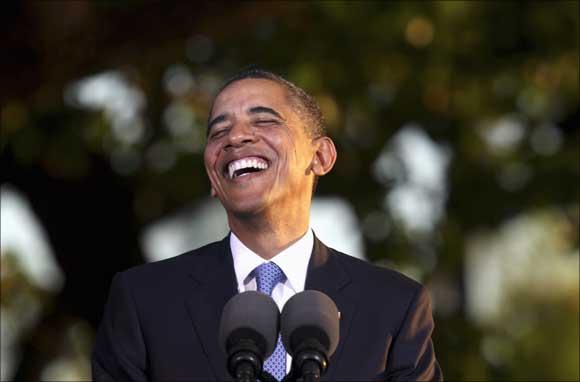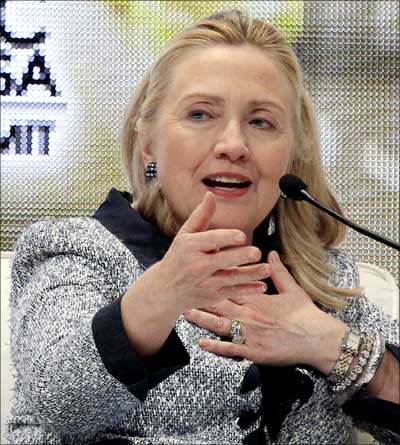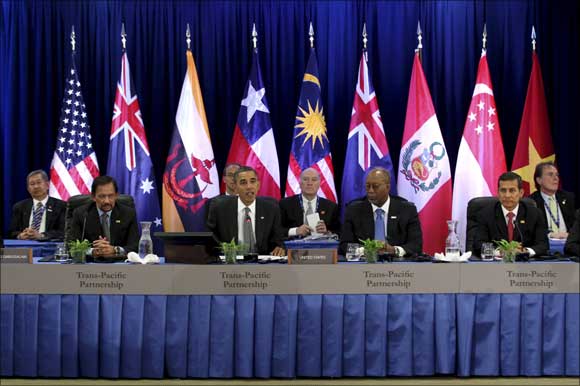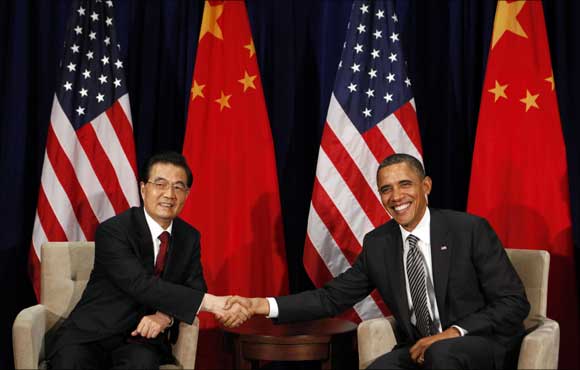 | « Back to article | Print this article |
The strategy behind America's Pacific offensive!
Sanjaya Baru, former media adviser to the Indian prime minister, in this exclusive column to Rediff.com writes that the United States is creating a new strategic framework for the 21st century and its Trans-Pacific Partnership is just one of the pillars of the new edifice.
Last week the leaders of the Group of Twenty (G-20) shelved, if not buried, the World Trade Organisation's already comatose Doha Development Round of multilateral trade negotiations at their meeting in Cannes.
The recession and crisis weary trans-Atlantic economies that are up against the rising tide of protectionism at home, are trying to find ways to blunt the edge of China's non-transparent trade competitiveness.
This weekend, turning his attention from the Atlantic to the Pacific, United States President Barrack Obama unveiled, however, a new regional trade initiative with, once again, an eye on China.
Why was the US unwilling to move forward on the Doha Round but is willing to pursue a regional free trade agreement?
The answer lies in the fact that the Trans-Pacific Partnership (TPP), launched by President Obama and the heads of government of eight other Pacific region economies -- Australia, Brunei Darussalam, Chile, Malaysia, New Zealand, Peru, Singapore and Vietnam -- is not just about trade.
Click NEXT to read on . . .
The strategy behind America's Pacific offensive!
While President Obama chose to stick to the economic factors driving the process, US Secretary of State Hillary Clinton laid out a wider strategic framework to the initiative in her remarks at Hawaii's East West Center on Thursday, on the eve of the Asia Pacific Economic Cooperation (APEC) gathering.
Ms Clinton said, "It is becoming increasingly clear that, in the 21st century, the world's strategic and economic center of gravity will be the Asia-Pacific, from the Indian subcontinent to western shores of the Americas. One of the most important tasks of American statecraft over the next decade will be to lock in a substantially increased investment -- diplomatic, economic, strategic, and otherwise -- in this region."
Secretary Clinton's speech ended on a high note: "The United States will continue to make the case that, as a region, we must pursue not just more growth but better growth. This is not merely a matter of economics. It goes to the central question of which values we will embrace and defend. Openness, freedom, transparency, and fairness have meaning far beyond the business realm. Just as the United States advocates for them in an economic context, we also advocate for them in political and social contexts."
Following up these remarks over the weekend, President Obama drew attention to persistent US concern about China's exchange rate policy, inadequate protection of intellectual property and the impediments to market access.
"For an economy like the United States -- where our biggest competitive advantage is our knowledge, our innovation, our patents, our copyrights -- for us not to get the kind of protection we need in a large marketplace like China is not acceptable," observed President Obama.
Click NEXT to read on . . .
The strategy behind America's Pacific offensive!
It is against this wider background, and not just in the context of the collapse of the Doha Round that one must view the TPP initiative.
The nine sponsors of TPP have resolved "to establish a comprehensive, next-generation regional agreement that liberalizes trade and investment and addresses new and traditional trade issues and 21st-century challenges."
The heads of government have agreed to fast track the TPP initiative and to consider opening up to other members, most importantly Japan, a late convert to the idea of a Pacific region free trade agreement.
TPP's agenda is divided into three categories: core, cross-cutting and new emerging issues.
The core agenda would be to stitch together a traditional FTA focussed on industrial goods, agriculture and textiles, that would also have provisions for intellectual property protection and what have come to be dubbed the social and environmental issues.
Click NEXT to read on . . .
The strategy behind America's Pacific offensive!
In short, TPP's core agenda will offer the region a 'Doha Round type' agreement that would also include a social and environmental agenda that the developing economies have been resisting within the WTO.
Going beyond the 'core' are what have been called the 'cross-cutting issues', including regulatory systems that would be foreign investor friendly and policies that would enable 'innovative' or 'employment-creating' small and medium enterprises to operate freely across borders within the TPP region.
Going beyond the 'core' and 'cross-cutting' issues, the TPP also seeks to bring into the ambit of a trade and investment agreement 'new and emerging' issues such as "trade and investment in innovative products and services, including digital technologies, and ensuring state-owned enterprises compete fairly with private companies and do not distort competition in ways that put US companies and workers at a disadvantage."
The ghost of China, quite clearly, haunts the region and the US has moved in to bring together all economies that are worried about China's 'beggar-my-neighbour' trade and exchange rate policies.
As a group, the nine TPP countries include a population of 500 million, and for the US the TPP eight constitute its fourth largest goods and services export market, next only to China, European Union and Japan.
Click NEXT to read on . . .
The strategy behind America's Pacific offensive!
If Japan joins in, the importance of the TPP would only rise.
While the economics of the TPP is important in itself, the geo-economics is clearly even more important. This is the second leg of the US 'Pacific Offensive", aimed at dealing with a rising China and offering nations in the region an alternative to excessive and rapidly growing dependence on China.
The first leg of the new Pacific offensive was the idea of the "Indo-Pacific" region that Ms Clinton first developed an year ago at the East West Center in Hawaii and followed up this year with an essay on "America's Pacific Century" in Foreign Policy (November 2011) in which she defines the new region of US strategic engagement as "stretching from the Indian subcontinent to the western shores of the Americas, the region spans two oceans -- the Pacific and the Indian -- that are increasingly linked by shipping and strategy. It boasts almost half the world's population. It includes many of the key engines of the global economy, as well as the largest emitters of greenhouse gases. It is home to several of our key allies and important emerging powers like China, India, and Indonesia."
Sailing east via the Indian Ocean and west via the Pacific, the United States is creating a new strategic framework for the 21st century. The TPP is just one of the pillars of the new edifice.
Sanjaya Baru is Director for Geo-economics and Strategy, International Institute of Strategic Studies (IISS), and the author of The Strategic Consequences of India's Economic Performance, Routledge, London, 2007. He can be reached at baru@iiss.org




